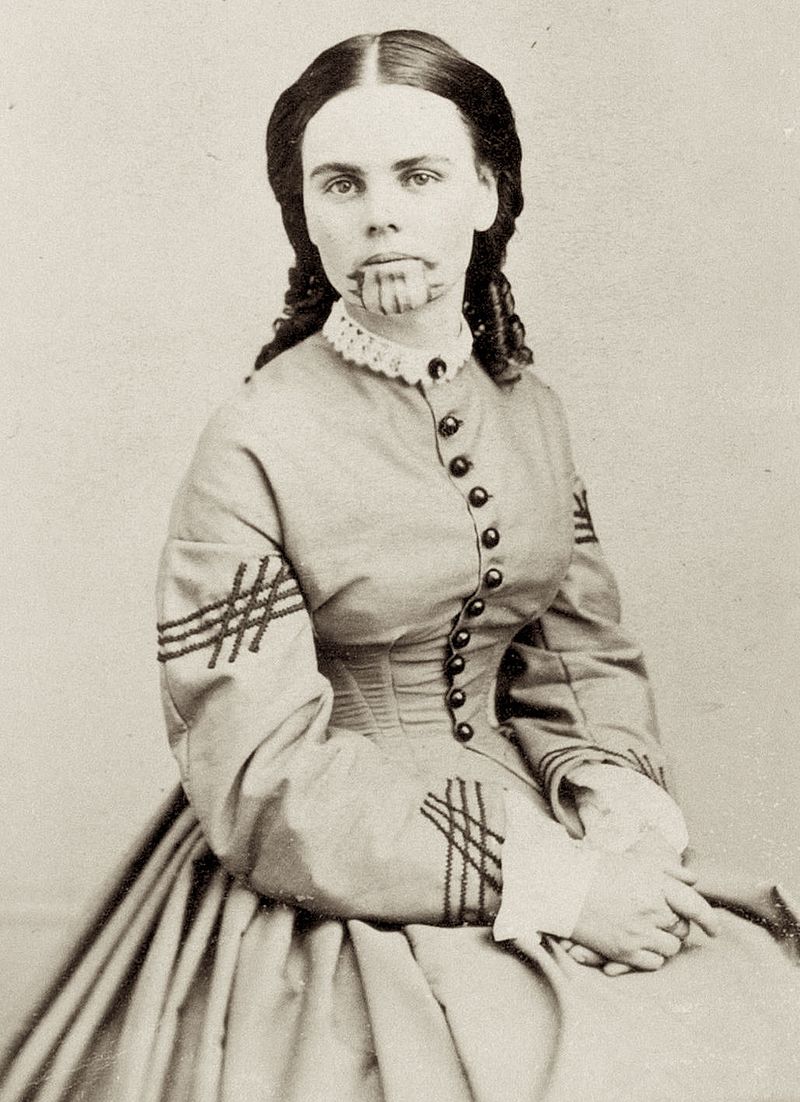Olive Oatman
Olive Ann Oatman Fairchild is known as the young teenager who survived a massacre of her family and lived among Native Americans for five years before being found and returned to Western culture. She was a member of The Church of Jesus Christ of Latter-day Saints.
Oatman was born on September 7, 1837, in Illinois. She was one of seven children of Royce Oatman and his wife Mary Ann. In 1850, her father took his family and joined a wagon train led by James C. Brewster, who disagreed with Church leadership in Salt Lake City and decided to begin his own sect and travel to California, which he considered the correct place of gathering. He later indicated that the Rio Grande Valley was the destination.
The Oatman family were part of the approximately 90 Latter-day Saints who followed Brewster from Missouri. The group split near Sante Fe, New Mexico Territory, with Brewster following the northern route and Oatman and other families following the southern route. When they arrived in 1851, the land was unsuitable for their purposes. The group was told that the trail was dangerous and they would be risking their lives if they proceeded. The other families decided to stay, but the Oatman family traveled alone. Four days outside of Maricopa Wells, a group of Yavapais Native Americans approached them and asked for food and tobacco. Royce was reluctant to share too much of their scant supplies, and the Yavapais became incensed. The family was clubbed. Fifteen year old Lorenzo was left for dead and Olive (age 14) and Mary Ann (age 7) were taken to be slaves. When Lorenzo came to, he saw his dead family and noticed that Olive and Mary Ann were not among them. After rejoining the emigrants. They helped him bury his dead family and he resolved to find his sisters. He never stopped his search for them.
Five Years Among Native Americans
Although Olive later identified the Native Americans as Apaches, it was not uncommon to describe all Southwestern tribes with the term Apache. The girls were treated as slaves, were beaten, burned as they worked, and were not given much food. They lived with the Yavapais for approximately one year.
A group of Mohave Native Americans came to trade one day and swapped horses, blankets, and vegetables for the girls. They were taken to a Mohave village near the current city of Needles, California. There they were adopted as members of the community and were tattooed with blue cactus ink on their chins and upper arms. The tribal leader Espianole took the girls into his family. They formed bonds with their adopted mother, Aespaneo, and her daughter, Topeka. Neither tried to escape and when 200 white railroad surveyors spent a week with the Mohaves in February 1854, they did not reveal themselves as kidnapped and did not ask for help.
During a severe drought in the Southwest a few years later, Mary Ann starved to death along with members of the Mohave tribe. Aespaneo cared for Olive by feeding her a gruel and she was able to survive.
Her Return to Her Brother
In 1855, the Mohave were told that the U.S. governments had heard rumors of a young white woman living with them. The tribe first kept her sequestered and then denied that she was white. But under pressure they began to worry about the threats from the U.S. government that they would destroy the tribe if she was not returned. Olive herself was involved in the negotiations (as was the Yuma Indian messenger who had told the tribe about the rumor). She told the truth about her being American and the Mohaves threatened her life. She was given back to the U.S. government in exchange for a white horse, some blankets, and some beads. After a 20-day journey, she arrived in Fort Yuma on February 22, 1856. It had been five years since her capture.
Olive was told that her brother, Lorenzo, had survived and they were reunited a few days after her arrival at the fort. She moved with him to Oregon.
In 1857, a pastor named Royal B. Stratton interviewed Olive and Lorenzo and wrote the bestseller Life Among the Indians (later renamed Captivity of the Oatman Girls). The proceeds paid for their education at the University of the Pacific. They accompanied him on a book tour and many people came to see the first-known tattooed American woman.
In 1865 she married cattleman John B. Fairchild, whom she had met at a lecture she gave with Stratton. They lived in Sherman, Texas. She became known as the town’s “Veiled Lady” and became involved with charity work. She and Fairchild adopted a little girl.
Olive died of a heart attack on March 20, 1903. The town of Oatman, Arizona, and Olive City, Arizona, are named in her honor. Also in her honor are Oatman Mountain, Oatman Flat, and Oatman Flat Station.
Inconsistencies in Her Story
Olive maintained that the Native Americans never took advantage of her sexually and that she was never raped and never engaged in sexual activity with any members of the tribe. One of Olive’s friends said that Olive had married a Mohave man and had given birth to two sons. Olive denied this story.
Olive said she was tattooed so that she could be identified if she escaped. But most Mohave women had facial tattoos.
Olive was described as deeply unhappy for the rest of her life and wanted to return to the Mohaves. However, she apparently also referred to them as “savages” in her lectures.
